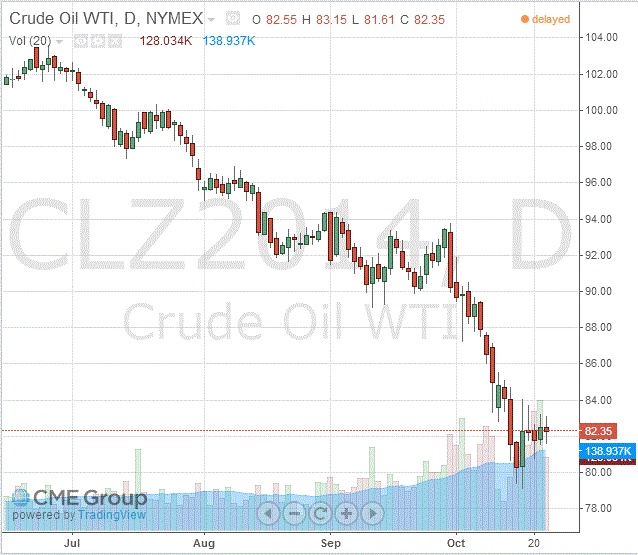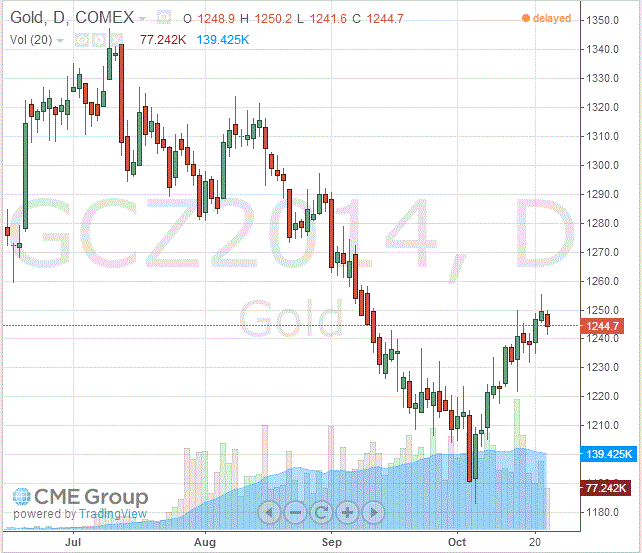Notícias do Mercado
-
16:41
Oil: an overview of the market situation
The cost of WTI crude oil fell slightly today, which was associated with the release of a report on oil stocks, which have more substantial than the expected increase. Prices for Brent, the meanwhile, rose moderately.
Department of Energy reported that commercial oil stocks in the United States in the week October 11 - 17 increased by 7.1 million barrels to 377.7 million barrels, while the average forecast of anticipated increase of 3.1 million barrels. Inventories rose to a maximum with the 4th of July. Oil reserves in the terminal Cushing rose 953,000 barrels to 20.6 million barrels. Gasoline inventories fell by 1.3 million barrels to 204.4 million barrels. Gasoline inventories have reached the lowest level since Nov. 23, 2012. Analysts had expected gasoline inventories are reduced as compared to the previous week by 1.4 million barrels. Distillate inventories rose 1 million barrels to 125.7 million barrels, while analysts had expected a decrease of 1.5 million barrels. We also learned that the utilization of refining capacity has decreased to 86.7% from 88.1%, reaching the lowest level since March 21. Analysts expected a decline of 0.2%.
Yesterday the American Petroleum Institute reported that crude oil inventories increased by 1.2 million barrels for the week ending 17 October. The report also showed that gasoline inventories fell by 532,000 barrels, while distillate stocks fell by 822,000 barrels.
Pressure on prices continues to concern about the weakening global demand, as well as signs that the Organization of Petroleum Exporting Countries will not cut production to support oil prices. Some analysts believe that only a decline in production in the oil cartel will be able to stop the decline in prices.
"If OPEC countries do not come to a common position on the acceptable level of oil and reduce production, it is likely, oil will be around $ 80 to $ 90," - said the expert GHP Group.
Little support is provided by statistics from China, which was better than expected. China's GDP grew in the third quarter of 2014 by 7.3% in annual terms, however, were lower than in the second quarter. At the same time, analysts predicted value of the index of 7.2%.
The cost of the November futures for the American light crude oil WTI (Light Sweet Crude Oil) fell to $ 82.35 a barrel on the New York Mercantile Exchange (NYMEX).
The price of December futures for North Sea Brent crude oil mixture rose $ 0.62 to $ 86.84 a barrel on the London exchange ICE Futures Europe.
-
16:20
Gold: an overview of the market situation
Gold prices declined moderately today, departing from the six-week high, which was associated with the strengthening of the dollar to one-week high against the euro and the physical signs of reduced demand.
Market participants are also expected to release the Chinese manufacturing PMI from HSBC for September, which will tell about the health of the economy. On Tuesday, the government data showed that on an annualized basis, China's economy grew in the third quarter by 7.3%, compared with growth of 7.5% in the previous quarter. While the figure exceeded market expectations of growth of 7.2%, it still was a minimum in the first quarter of 2009.
Experts point out that the relatively high price of gold reflects the uncertainty in the health of the global economy. Since the beginning of October, the gold has risen in price by more than 3 percent after a 6 percent drop in September. In the coming days, the market may decline as demand for gold in India and China reduced
"Gold and other metals were slightly oversold, and $ 1,200 - a sustained level of support. This month increased purchases in China, supported the gold, "- said Standard Bank analyst Yuichi Ikemidzu.
The course of trade was also affected by today's inflation data for the United States. As it became known, consumer prices rose slightly in September - this is the last sign of restrained inflationary pressures on the United States amid fears of a global slowdown. The consumer price index rose a seasonally adjusted 0.1% in September compared with the previous month, the Labour Department said. With the exception of volatile categories (food and energy) prices also rose by 0.1%. Economists had forecast the continued importance of the overall consumer price increase of 0.2% so-called core prices. Compared with a year earlier, consumer prices and prices excluding food and energy rose 1.7% each. Overall prices fell 0.2% in August.
The cost of the December gold futures on the COMEX today dropped to 1244.70 dollars per ounce.
-

